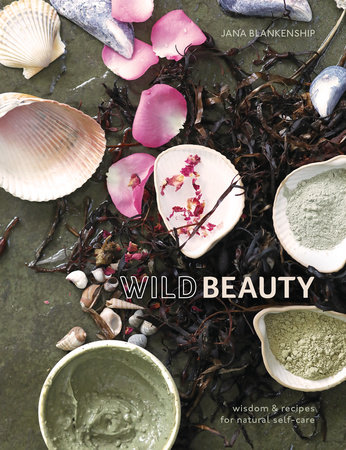Chapter 2 Aromatics Imagine you could dive into a bottle of natural perfume and inspect and savor every ingredient and each distinct smell. The perfumer creates work that is more than a sum of its parts, like an alchemist who transmutes matter into spirit. Perfume reacts differently on each body it touches because everyone’s body chemistry and sense of smell are different. In addition, each plant essence has its own structure that, when combined into a perfume, becomes something else entirely, a harmonious work of art. A perfume is traditionally made of base notes, middle notes, and top notes, which is a direct reference to music. When certain scents align and enhance each other, they are called chords. To create a well-balanced perfume is to develop a real harmony, one in which each element depends on the others to make it sing. Let’s delve into how we grow a harmonious perfume from the ground up.
In a simple blend, you could choose one base note, one middle note, and one top note to start. In more complicated perfumes, you could have three or four of each note. Before diving in, it is helpful to take some time to reflect on the character of the perfume you want to create. If you want orange blossom to be a star in your perfume, you should try not to bury it with heavier scents. Take some time to brainstorm before you start blending. You can always add more drops, but you cannot subtract them. There is nothing sadder than creating mud out of precious materials and needing to start over.
In this chapter, I want to introduce you to some of my favorite essential oils and then some simple recipes for scent blends for well-being, room sprays, and perfumes. That said, scent is entirely subjective, and you may have different preferences than I do. Feel free to adjust the scent blends to your liking, and above all, trust your nose. You are the most important ingredient.
Base Notes Mandy Aftel uses the metaphor of a tree to talk about plant essences. The base notes are the roots of the tree, the resinous scents that build the foundation of a perfume. They often are made from actual roots, like vetiver. Other popular base notes include frankincense, myrrh, vanilla, patchouli, palo santo, sandalwood, seaweed, oak moss, and violet leaf. These base notes are heavy, rich, and syrupy in smell and are what gives perfume longevity. When building
a perfume, you work from the ground up.
Middle Notes From the roots, we come to the flowers and leaves of the tree: the middle notes, which are the precious heart of a scent. Flowers such as jasmine, rose, tuberose, ylang ylang, geranium, and orange blossom are middle notes. Leaves, needles, and grasses are also in this category, including eucalyptus, pine, spruce, cypress, and palmarosa.
Top Notes The first wave of a perfume that you smell are the top notes, but they are fleeting. The top notes, the fruits of the tree, also include spices and herbs. All citrus fruits, spices, and most herbs are classified as top notes.
A Note on Ingredients I suggest using organic and wild-harvested essential oils, organic CO2 extracts, and organic carrier oils, but you can experiment and see what you like best. As always, follow your nose.
Citrus essential oils should be kept in the fridge to keep them fresh. I like to use golden jojoba oil (not deodorized) for scent blends, but sunflower and safflower are also options. All three carrier oils are easily absorbed by the skin and don’t carry much of a scent themselves, making them the perfect vehicle for essential oils.
A Note on Blending Please think of these as sketches that you can adapt to your liking. Scent is personal, and you should feel free to make changes and substitutions and make these your own work of art. Always remember you can add, but you can’t subtract. Start slow with drops and add more if you desire. Cutting up scent strips made out of small strips of drawing paper and dipping them into your draft is a good way to get a sense of where the scent is and where you want to take it.
Equipment Most of the equipment used in these recipes includes common kitchen items, such as a small pot, small strainer, mixing bowls, large and small heatproof spouted glass measuring cups, measuring spoons, metal spoons for stirring, spatula, and metal funnel. You will also need eyedroppers.
All of the 1/2-ounce recipes require glass aromatherapy roll-on bottles (use either a single 1/2-ounce bottle or two 1/4-ounce bottles). All of the 4-ounce recipes require 4-ounce glass bottles with fine-mist sprayers. Additional items will be noted after the ingredient lists.
Loosen the Knot Tension-Release Blend This powerful blend of essential oils is great for relieving anxiety, tension, headaches, migraines, and PMS. Dab onto wrists and temples, breathe in, and close your eyes.
Yield: 1/2 ounce
Ingredients
1 tablespoon carrier oil of choice
8 drops peppermint essential oil
7 drops eucalyptus essential oil
5 drops clary sage essential oil
3 drops rosemary essential oil
Optional: 5 drops lavender essential oil*
*Use if you or your friends love lavender; some people don’t.
1. Add carrier oil to small spouted measuring cup. With separate eyedroppers, add essential oils to carrier oil and combine with spoon. With funnel, pour slowly into roll-on bottles. Press on roll-on lid and screw on cap.
2. Use as needed. If stored out of direct sunlight, will keep for up to 2 years.
Cocoa & Spice Face Mask & Exfoliant This is a sumptuous mask and gentle exfoliant that I love in wintertime, but it is a great year-round treatment. It smells like spicy cocoa and soothes and clarifies skin without drying it out. Using activated charcoal and bentonite clay, which detoxify, along with antioxidant-rich
raw cocoa powder and a potent blend of invigorating spices will leave your skin and senses feeling revived.
Yield: 1 1/2 ounces
Ingredients
1 tablespoon bentonite clay or kaolin clay
1 teaspoon activated bamboo charcoal powder
1 tablespoon raw cocoa powder
1 teaspoon ground turmeric
1/4 teaspoon ground nutmeg
1/4 teaspoon ground cinnamon
1/4 teaspoon ground ginger
Additional Equipment
2-ounce glass jar with lid
Mix all ingredients together in small bowl. Pour into jar and close with lid. Will keep fresh for up to a year.
AS FACE MASK
Combine 1/2 teaspoon mix with 1/8 teaspoon water or hydrosol in small dish. Mix into paste and add more liquid if necessary for desired consistency. Apply to moist face and neck with fingers or brush. Leave on for 5 to 10 minutes, then rinse with lukewarm water. Pat dry with clean towel; apply toner and face oil or face balm.
AS EXFOLIANT
Apply quarter-size amount to wet face with fingers, massage gently into skin, and rinse with lukewarm water. Pat dry with clean towel; apply toner and face oil or face balm.
Copyright © 2019 by Jana Blankenship, founder of Captain Blankenship. All rights reserved. No part of this excerpt may be reproduced or reprinted without permission in writing from the publisher.









